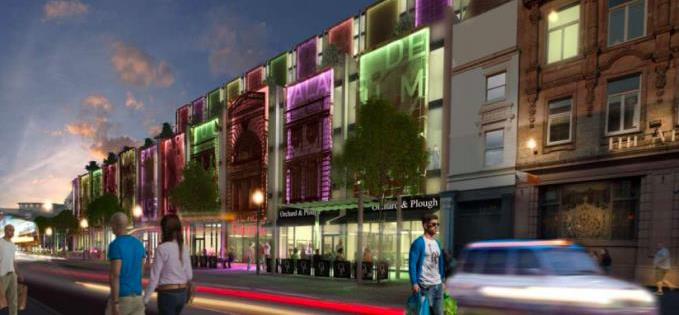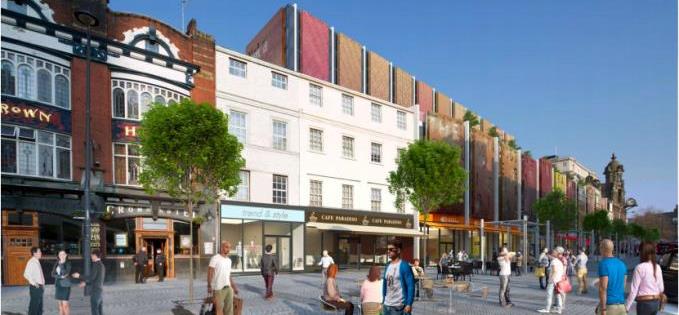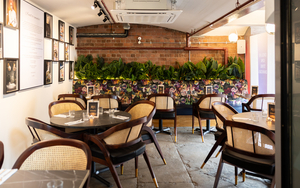PLANNERS in Liverpool said today the go-ahead should be given for the revised regeneration plans for Lime Street, revealed last month by Liverpool Confidential.
The recommendation, which will spell the end of the Futurist and its fine classical façade comes despite scores of written protests from individuals and heritage bodies.
While accepting that the interior of the picture house may be beyond saving, The Cinema Theatre Association, in a formal objection, urged that the "splendid frontage" be kept and incorporated into revamped city gateway.
The Victorian Society has joined the chorus of outrage saying the Lime Street blueprint - if it is apporved by the Planning Commitee next Tuesday - will cause serious, unjustified and irreversable harm to Liverpool’s unique historic environment.
Developers Regeneration Liverpool and local builder Neptune went back to the drawing board after their first scheme was heavily criticised.
Their amended plans received a warmer welcome, even though the fate of Liverpool’s oldest purpose-built cinema was all but sealed.
As in the first scheme, take two will see the demolition of a number of buildings in the stretch of Lime Street between the two Victorian gin palaces, The Vines and The Crown. But new buildings will be lit at night to incorporate "relevant wording, names, patterns and even the outline of facades on the cladding panels".
 The scheme being recommended sees The Futurist replaced by pictures: 'relevant wording, names, patterns and the outline of facades on the cladding panels'
The scheme being recommended sees The Futurist replaced by pictures: 'relevant wording, names, patterns and the outline of facades on the cladding panels'The revised scheme will see a mixed use development, including 3,022sqm of commercial accommodation covering the ground floor, divided into individual units to be used for retail, commercial offices, food and drink and restaurants. Above there will be an hotel as well as an 11 storey, 412 bedroom student residential block comprising six studio rooms and 70 clusters of accommodation, each with between four and six bedrooms with communal living and kitchen areas.
In between these two blocks, it is proposed to create a podium level which will provide for a semi-private space to be used predominately as a spill out space for the student residents and hotel/restaurant guests.
More than 60 letters of objection, including 19 from outside the city, were received by the planning department.
Officers say that although there is a general consensus that the area is in need of regeneration the objections raised centred mainly on the proposed demolition of historically significant buildings, particularly The Futurist.
In its objection, The Victorian Society adds that the eastern side of Lime Street contributes to the setting of the World Heritage Site and plays an important role in views in and out of it.
“The almost total clearance of the site and the loss of historic fabric it would entail would have a drastic and deleterious impact on Liverpool’s historic environment. It would result in the loss of buildings that are identified as significant positive components,” it wrote. They conclude the scheme would cause serious harm which would be both unjustified and irreversible.

Merseyside Civic Society says buildings in Lime Street have the potential to be brought back into full beneficial use, with careful adaptions, with a view to retaining this important contribution to the overall character and appearance of this part of the city’s historic fabric. They consider greater weight should have been given to the retention of the Futurist’s façade.
Other objections hit out at the scheme, with some saying the revised plan is worse than the last proposal. The design is dated, bland and unimaginative, say others, with another critic saying “the scheme is inappropriate, monolithic and cheap looking and is not ambitious enough for this location".
Nevertheless, the council’s Head of Planning says he is satisfied that the loss of the buildings will have no adverse impact on the setting of designated assets, including listed buildings, adjoining conservation areas or the World Heritage Site.
The scheme, he adds, will contribute towards a sustainable mix of uses in an accessible location, benefiting the local economy and providing enhanced employment prospects.
For the face of The Futurist it's The Long Goodbye.












